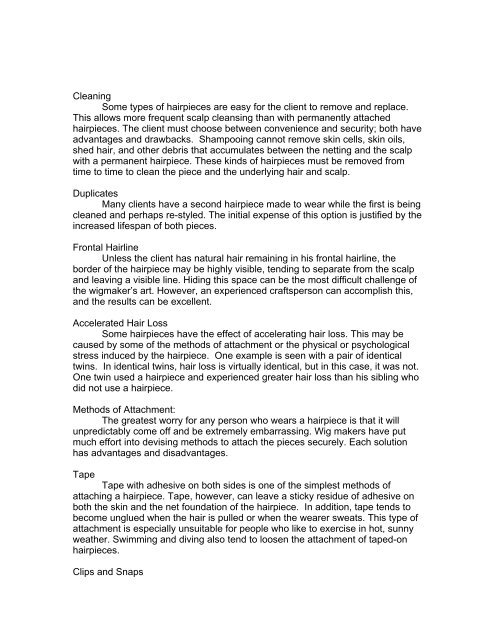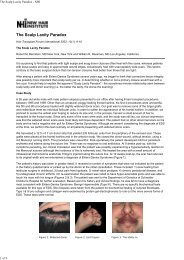The Patient's Guide to Hair Restoration - New Hair Institute
The Patient's Guide to Hair Restoration - New Hair Institute
The Patient's Guide to Hair Restoration - New Hair Institute
You also want an ePaper? Increase the reach of your titles
YUMPU automatically turns print PDFs into web optimized ePapers that Google loves.
Cleaning<br />
Some types of hairpieces are easy for the client <strong>to</strong> remove and replace.<br />
This allows more frequent scalp cleansing than with permanently attached<br />
hairpieces. <strong>The</strong> client must choose between convenience and security; both have<br />
advantages and drawbacks. Shampooing cannot remove skin cells, skin oils,<br />
shed hair, and other debris that accumulates between the netting and the scalp<br />
with a permanent hairpiece. <strong>The</strong>se kinds of hairpieces must be removed from<br />
time <strong>to</strong> time <strong>to</strong> clean the piece and the underlying hair and scalp.<br />
Duplicates<br />
Many clients have a second hairpiece made <strong>to</strong> wear while the first is being<br />
cleaned and perhaps re-styled. <strong>The</strong> initial expense of this option is justified by the<br />
increased lifespan of both pieces.<br />
Frontal <strong>Hair</strong>line<br />
Unless the client has natural hair remaining in his frontal hairline, the<br />
border of the hairpiece may be highly visible, tending <strong>to</strong> separate from the scalp<br />
and leaving a visible line. Hiding this space can be the most difficult challenge of<br />
the wigmaker’s art. However, an experienced craftsperson can accomplish this,<br />
and the results can be excellent.<br />
Accelerated <strong>Hair</strong> Loss<br />
Some hairpieces have the effect of accelerating hair loss. This may be<br />
caused by some of the methods of attachment or the physical or psychological<br />
stress induced by the hairpiece. One example is seen with a pair of identical<br />
twins. In identical twins, hair loss is virtually identical, but in this case, it was not.<br />
One twin used a hairpiece and experienced greater hair loss than his sibling who<br />
did not use a hairpiece.<br />
Methods of Attachment:<br />
<strong>The</strong> greatest worry for any person who wears a hairpiece is that it will<br />
unpredictably come off and be extremely embarrassing. Wig makers have put<br />
much effort in<strong>to</strong> devising methods <strong>to</strong> attach the pieces securely. Each solution<br />
has advantages and disadvantages.<br />
Tape<br />
Tape with adhesive on both sides is one of the simplest methods of<br />
attaching a hairpiece. Tape, however, can leave a sticky residue of adhesive on<br />
both the skin and the net foundation of the hairpiece. In addition, tape tends <strong>to</strong><br />
become unglued when the hair is pulled or when the wearer sweats. This type of<br />
attachment is especially unsuitable for people who like <strong>to</strong> exercise in hot, sunny<br />
weather. Swimming and diving also tend <strong>to</strong> loosen the attachment of taped-on<br />
hairpieces.<br />
Clips and Snaps



